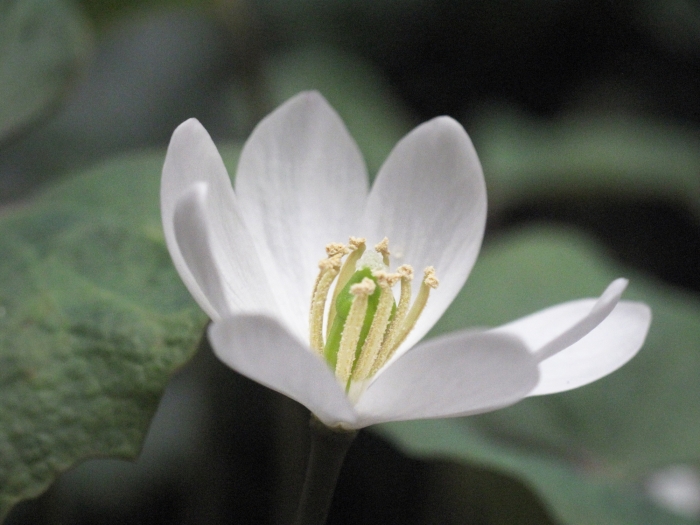Twinleaf
(Jeffersonia diphylla)
Twinleaf (Jeffersonia diphylla)
/
/

Kevin Gepford
CC BY-SA 3.0
Image By:
Kevin Gepford
Recorded By:
Copyright:
CC BY-SA 3.0
Copyright Notice:
Photo by: Kevin Gepford | License Type: CC BY-SA 3.0 | License URL: https://creativecommons.org/licenses/by-sa/3.0 | Uploader: Kevin Gepford | Publisher: Wikimedia Commons | Title: Jeffersonia_diphylla_closeup.jpg | Notes: |



















































Estimated Native Range
Summary
Jeffersonia diphylla, commonly known as Twinleaf, is a deciduous perennial herb native to rich, deciduous forests in the Eastern United States and Ontario. It typically grows to a height of 12 inches (30 cm) and features smooth leaves that emerge directly from the rhizome. Each leaf is divided into two leaflets that are half-ovate in shape with entire or shallowly toothed margins. Twinleaf is notable for its showy white flowers, which have four sepals, eight petals, eight stamens, and a single pistil, bearing a resemblance to bloodroot flowers. The flowers bloom in April or May, often before the forest canopy fully develops, and are short-lived. The plant’s seeds are dispersed by ants, a process known as myrmecochory, which is a fascinating aspect of its ecology.
In the garden, Twinleaf is valued for its unique foliage and attractive early spring flowers. It is often used in woodland gardens, shade gardens, and native plant gardens. While it prefers part shade, it requires medium amounts of water and thrives in soils with slow to medium drainage. Gardeners should note that Twinleaf can be slow to establish and may not flower prolifically in the first few years. It is not commonly afflicted by diseases or pests, but its habitat should be protected from disturbance to ensure its survival.CC BY-SA 4.0
In the garden, Twinleaf is valued for its unique foliage and attractive early spring flowers. It is often used in woodland gardens, shade gardens, and native plant gardens. While it prefers part shade, it requires medium amounts of water and thrives in soils with slow to medium drainage. Gardeners should note that Twinleaf can be slow to establish and may not flower prolifically in the first few years. It is not commonly afflicted by diseases or pests, but its habitat should be protected from disturbance to ensure its survival.CC BY-SA 4.0
Plant Description
- Plant Type: Herb
- Height: 0.8-1.5 feet
- Width: 0.5-0.8 feet
- Growth Rate: Slow
- Flower Color: White
- Flowering Season: Spring
- Leaf Retention: Deciduous
Growth Requirements
- Sun: Part Shade
- Water: Medium
- Drainage: Slow, Medium
Common Uses
Bee Garden, Low Maintenance, Rock Garden, Showy Flowers
Natural Habitat
Rich, deciduous forests in the Eastern United States and Ontario
Other Names
Common Names: Rheumatism Root, Jeffersonie À Deux Feuilles
Scientific Names: , Jeffersonia diphylla, Jeffersonia binata, Podophyllum diphyllum, Jeffersonia bartonis, Jeffersonia diphylla f. diphylla, Jeffersonia lobata, Jeffersonia odorata, Vindicta begonifolia,
GBIF Accepted Name: Jeffersonia diphylla (L.) Pers.